Unter den Linden, a main east-west thoroughfare through the city of Berlin, earned its name from the rows of linden trees that were first planted there more than three-and-a-half centuries ago.
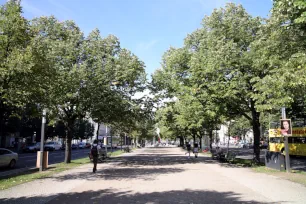
This prestigious boulevard leads from the Palace Bridge near Museum Island to the Brandenburg Gate at Pariser Platz. The street stretches 1.5 kilometers long and is sixty meters wide. It is planted with four rows of Linden trees, about one thousand in total.
History
The Trees
Duke Frederick William, also known as The Great Elector, was dedicated to the development and beautification of Berlin during his reign in the mid-1600s. In order to spruce up the route from his castle home to the Tiergarten hunting ground, it is said that Frederick ordered the planting of long rows of Linden trees, which would also serve to keep the route more shady and comfortable for his travels. That means his carriage ride would have him traveling “unter den Linden”; literally, under the lindens.
The Street Grows
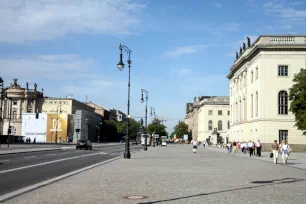
Nearly a century later, King Frederick II expanded the boulevard by adding his collection of cultural buildings to the area, including the national opera house and the national library, making Unter den Linden larger and more popular.
By the nineteenth century, it was one of the most visited streets in the city and served as a central gathering place for many Berlin citizens. After the victory over Napoleon, the street was furnished with a plethora of statues standing in homage to the great generals of the German army and a guardhouse was built as a memorial to the victory in the Wars of Liberation (against Napoleon).
After World War II
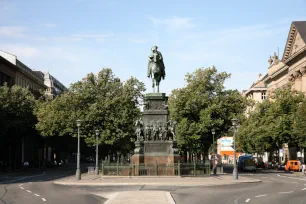
By the end of World War II, Unter den Linden had been reduced to little more than rubble and the magnificent linden trees had been cut down. The East German Government did little to rebuild the area, and after they erected the Berlin Wall in 1961 Unter den Linden was closed off right before the Brandenburg Gate. The street lost its central function and became deserted.
After the fall of the wall in 1989, the street quickly revitalized and one by one all buildings along the boulevard were either restored or rebuilt.
Sights
Today, you’ll find a number of wonderful architectural sights along Unter den Linden, many of which date back to the heyday of the Prussian Kingdom.
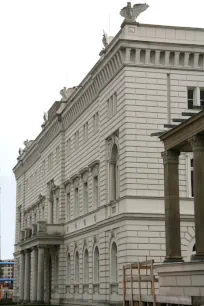
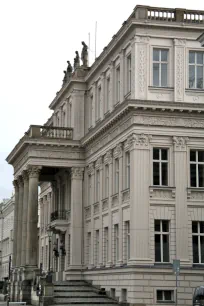
Alte Kommandantur
Starting at the Palace Bridge walking towards the Brandenburg Gate, the first building on the left is the Alte Kommandantur, originally built in 1795. In 1799, it became the headquarters of the military commander of Berlin, hence the name.
The building was damaged in the Second World War and later demolished by the East German government. In 2003 the front facade was recreated from photos since no original drawings could be found. Unfortunately, the Neo-Renaissance facade is no more than an act of ‘Facadism’ since an entirely modern office building was erected behind it.
Kronprinzenpalais
Next to the Alte Kommandantur is the Kronprinzenpalais (Crown Prince’s Palace). It was built in 1664 as a private residence and from 1732-1918 served as a royal residence for the Hohenzollerns. The palace was demolished during the Second World War and rebuilt in 1968. The German Reunification Treaty was signed here in August 1990.
The building is connected to the Prinzessinnenpalais (Princess’s Palace), better known as the OpernPalais. It was built in 1733 as a palace for the Hohenzollern family. The palace was completely destroyed during World War II and subsequently rebuilt between 1960-1962.
Zeughaus
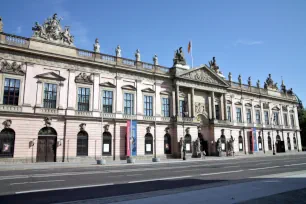
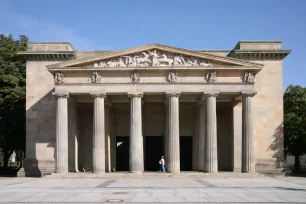
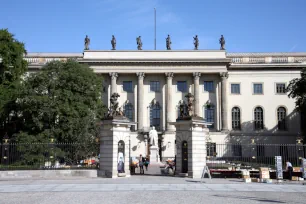
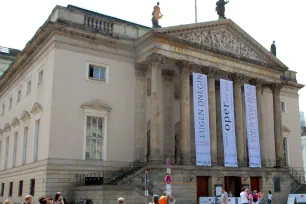
Opposite the Crown Prince’s Palace is one of the most beautiful buildings on Unter den Linden: the Zeughaus (Armory). Construction started in 1695 to a Baroque design by Johan Arnold Nering, and it was completed in 1706 by Andreas Schlüter. The building was severely damaged during the Second World War; it was repaired in 1967. Today it is home to the German Historical Museum, which traces the history of Germany from Roman times up to the Second World War.
Neue Wache
Next to the Zeughaus is the Neue Wache, which served as the guardhouse for the royal guards and is now the National Memorial to the Victims of War and Tyranny. It’s considered to be the finest masterpiece of German architect Karl Friedrich Schinkel. Inside, beneath an oculus, is a replica of Käthe Kollwitz’s sculpture «Mother with her Dead Son».
Humboldt University
The next building is the main campus of the Humboldt University. It was built in 1753 by Johan Bouman as a palace for Prince Henry, a brother of King Frederick II of Prussia. After the prince’s death the building was handed over to the Berlin University, which in 1949 was renamed Humboldt University in honor of its founder Wilhelm von Humboldt. Former students include Karl Marx and physicist Max Planck.
Bebelplatz
Opposite the Humboldt University lies Bebelplatz, a square bordered by some impressive buildings. Towards the east is the Staatsoper Unter den Linden, the Berlin State Opera. The opera house was built in 1743 by Georg Wenzeslaus Von Knobelsdorff as the Hofoper (Court Opera). It burned down in 1843 and was rebuilt by Carl Gotthard Langhans, the architect of the Brandenburg Gate.
The west side of Bebelplatz is dominated by the Alte Bibliothek (Old Library), which was built in 1775-1780 as the Royal Library. Today the building is used by the Humboldt University.
The Humboldt University also occupies the adjacent building, facing Unter den Linden. This is the Altes Palais (Old Palace), a classicist palace that was built between 1834 and 1837. Both the Old Library and Old Palace were destroyed during the Second World War and rebuilt in 1963-1964.
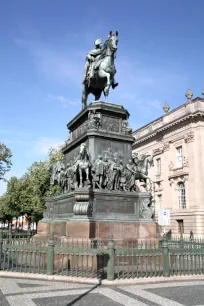
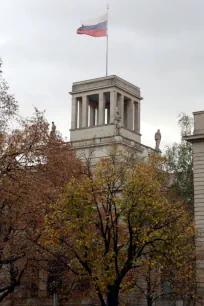
Statue of Frederick II
In front of the Old Palace stands the impressive equestrian statue of King Frederick II. The massive bronze monument was created between 1839 and 1851 by Christian Daniel Rausch. After WWII the statue was relocated to Potsdam, but now it has its place again at the center of Unter den Linden.
Staatsbibliothek
Opposite the Old Palace, next to the Humboldt University, is the massive building of the Staatsbibliothek, a branch of the Berlin State Library. The building was erected between 1908 and 1913 to house the Prussian library.
Russian Embassy
Further on towards Brandenburg Gate is a cluster of embassies. Among them the Russian embassy, which was already an embassy when tsars ruled over Russia. The building was destroyed during WWII. The current building, a typical example of Stalin-era Soviet architecture, was built between 1949 and 1952.
Madame Tussauds
On the opposite side, near Pariser Platz, is the Berlin branch of Madame Tussauds wax museum, which, like its counterpart in London, displays a waxen likeness of Adolf Hitler among other historical figures. There are also sports, music and movie stars, some international, others German like Marlene Dietrich.
- Next: Zoo
- More Sights & Attractions in Berlin

